SEO
SEO For Membership Sites: Getting Around The Paywall

Anyone who has done SEO for a period of time has heard the myth of Google’s 200+ ranking factors.
To be fair, the 200 number may have been somewhat accurate, when first mentioned by former Googler Matt Cutts, over a decade ago.
A lot has changed since then, and it’s unlikely that anyone knows the real number of ranking factors baked into the Google algorithm today.
That said, not all ranking factors are created equally.
If you simply focus on the top eight factors with the biggest influence, you will be successful. Those factors include:
- High-quality content.
- Mobile-first.
- Page experience.
- Page speed.
- On-page optimization.
- Internal links.
- External links.
- Local.
Here’s the rub: That only works IF your content is visible to Google and available to readers.
What if you put a paywall in front of your content, creating an extra step? Let’s take a look at how to do SEO for membership sites in 2022.
Why Put Your Content Behind A Paywall?
The obvious question is – why put your content behind a paywall if it will affect SEO in the first place?
The drawbacks are quite clear:
- Fewer people will see your content if it’s not visible to search engines.
- You need to make it worthwhile for them to pass through that gate.
- Some people may give you false information just to see your gated content.
That said, there are some benefits to it:
- You may get better-qualified leads as people who are willing to give you their personal information are more likely to have a high level of interest.
- It can help you segment and target your audience better.
- The audience will often perceive your content as more valuable, useful, and trustworthy (but you must deliver on it).
What Does Google Have To Say About Paywalled Content?
Regardless of whether your content is free or premium, you have to follow Google’s guidelines.
The biggest problem for premium content owners is how to be visible in search if their content is not freely available to all users.
To mitigate this, Google initially introduced a First Click Free (FCF) policy.
What that meant was that, in addition to their premium content, publishers had to provide some free content that users could access through Google search.
Suffice it to say that publishers weren’t the biggest fans of this model and it was discontinued in 2017, and replaced with “Flexible Sampling.”
Basically, the newer model gives publishers more maneuvering space in deciding how much of their content they want to provide free to users and how they want to provide it.
There are three options that publishers can choose from in Flexible Sampling.
Freemium
With the freemium model, some articles o
n the site can be accessed without a paywall, while some will have one.
In other words, this is a combination of gated and ungated content.
There’s no specific rule as to which content will be free and which premium, but usually, publishers use popular free content to leverage premium content and entice people to subscribe if they want to read, perhaps a more in-depth article.
Metered
With metered paywalls, the visitor can read a limited number of articles per month before he is being asked to subscribe. Usually, this is three articles, but it can be five or just one for example.
This method is used by several prominent websites, including Medium, The New York Times, and others.
Once you reach the limit, you’ll see a prompt like the one below to subscribe:
Hard Paywalls
The previous two methods are known as “soft” paywalls as they allow the visitor to see at least a few articles or even just a part of the content.
With “hard” paywalls, all content is gated off.
This means that content can’t be crawled or indexed by Google or other search engines. Obviously, this makes it much harder to get new signups, but if the content is of high value, the conversion rate can be much higher.
Although perhaps the least liked of all paywall methods, hard paywalls are still used by some top-tier websites in finance and other industries such as the Wall Street Journal, Financial Times, and others.
 Screenshot by author, February 2022
Screenshot by author, February 2022So Which Of The Three Is The Best Option?
This largely depends on the purpose of your content.
News platforms, such as the New York Times, have had good success with metered content. This model allows visitors to get a good idea of the quality of their content, by providing full samples as “teasers” to entice users to subscribe.
The NY Times, for example, introduced metered subscriptions back in 2011, and today, a decade or so later, 7.6 million out of 8.4 million total subscribers are digital subscribers, while only around 795,000 are print subscribers.
Here’s a chart of how their digital-only subscriptions grew from 2011 to 2021:
 Screenshot by author, February 2022
Screenshot by author, February 2022The Freemium method makes sense for a website that already has a large and loyal reader base, different kinds of content, and exclusive content.
Balancing Free & Premium Content
Free content has a clear advantage over premium content when it comes to organic search, due to its sheer volume. This doesn’t mean that premium content publishers will be devoid of organic search opportunities.
In fact, one could argue that engaging in SEO is MORE important for subscription sites, as they have an extra hurdle (paywall) to clear.
Premium content publishers actually have two good options:
- They can seek to find a balance between free and premium content like the New York Times does.
- Or they can create content that readers are searching for, but can’t get anywhere else. This content essentially needs to be exclusive.
In other words, one can’t put just any type of content behind a paywall.
Basic articles such as “How to Optimize Your Website for SEO” number in the thousands (millions?) on the web and can be found with a quick Google search for free. Users have no reason or motivation to pay for that kind of content.
On the other hand, if a publisher puts considerable effort into discovering a need and then creating a solution in the form of a whitepaper, ebook, or in-depth article, they can justify putting their specialized content behind a paywall.
If the content is authored by a renowned expert, so much the better.
In deciding whether to gate content or not, it may be a good idea to consider the following three questions.
1. What Is The “End Game”?
Are you looking to increase subscribers or generate leads? If so, then content should probably be gated in some way.
However, if you are looking to generate more visitors and links, the gating approach will be counterproductive.
2. Is The Content Worth Paying For?
Put yourself in the user’s shoes and answer this question: “Is this content valuable enough for me to pay for it or fill out a form?”
Be careful when answering this question. As the creator or curator of content, pride in authorship can make it difficult to be truly unbiased.
3. Is The Data Collected Worthwhile?
Another consideration when it comes to content gating is how it impacts the user experience. The rise in the use of pop-ups and overlays is directly responsible for the increase in adblocking software.
By forcing users to turn over personal information to access gated content, a (sometimes large) percentage of data collected consists of fake names and burner email accounts.
The “Fred” Update & The Difference Between Premium & Gated Content
In March 2017, Google introduced an algorithm update that was dubbed Fred.
The basic idea was to reward websites that provided a positive user experience and to demote websites light on quality content and heavy on ads.
Fred also had the unintended consequence of demoting some legitimate paywall websites.
Technical SEO Considerations For Paywalled Content
One initial problem with Fred was that it had difficulty in differentiating between paywalled and hidden (cloaked) content. Since then, Google has come up with a solution: structured data.
In order for paywalled content to be eligible to appear in Google search results, it needs to follow the Structured and Technical Guidelines.
Here is an example of how to indicate paywalled content to comply with Google’s guidelines:
 Screenshot by author, February 2022
Screenshot by author, February 2022The question is, “how is Googlebot able to read the content behind the paywall?” For example, if you look at this article with “view source,” the following is visible via the browser:
 Screenshot by author, February 2022
Screenshot by author, February 2022While the rest is behind a paywall…
And the answer is…
Namely, the site itself needs to use cloaking.
It sends the full content when Googlebot asks for the page, using the User-Agent HTTP header, for example:
 Screenshot by author, February 2022
Screenshot by author, February 2022One final, yet important point: Clever searchers have learned that paywalls can be bypassed by going into the Google cache and reading content for free.
To prevent this, one needs to use the noarchive robots meta tag, which will stop Google from showing the cached link to that page.
Conclusion
Paywalls are becoming increasingly common across the web. They allow publishers generate revenue by charging readers for access to articles or other content.
While they can be useful for providing premium content, they also limit free access to information. And, they can limit search bots from accessing what they need to know to properly catalog your website.
We hope these tips help you decide on whether to use a paywall or how to best optimize your paywall for search and profitable success.
More Resources:
Featured Image: Marija_Crow/Shutterstock
SEO
Measuring Content Impact Across The Customer Journey
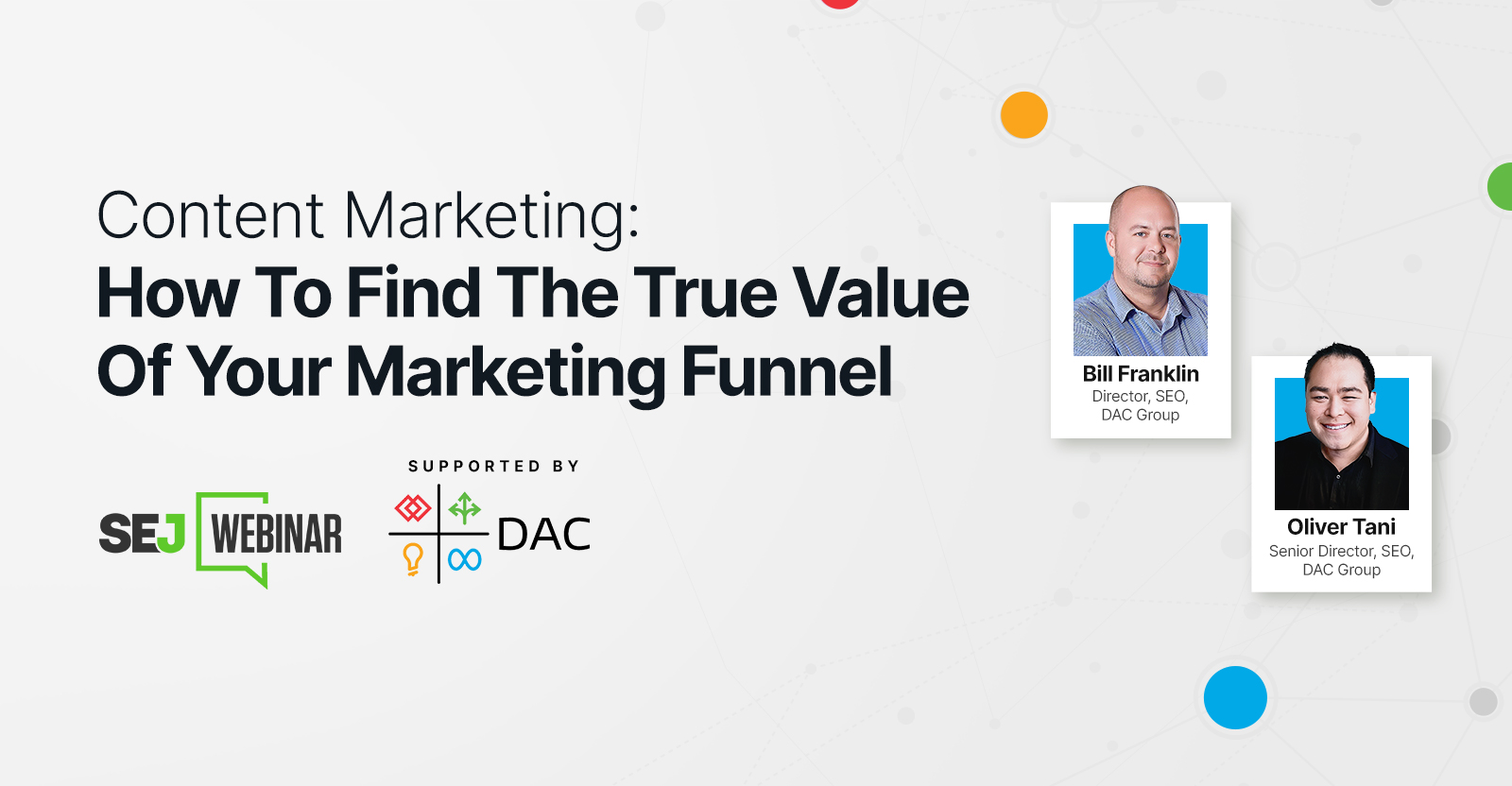
Understanding the impact of your content at every touchpoint of the customer journey is essential – but that’s easier said than done. From attracting potential leads to nurturing them into loyal customers, there are many touchpoints to look into.
So how do you identify and take advantage of these opportunities for growth?
Watch this on-demand webinar and learn a comprehensive approach for measuring the value of your content initiatives, so you can optimize resource allocation for maximum impact.
You’ll learn:
- Fresh methods for measuring your content’s impact.
- Fascinating insights using first-touch attribution, and how it differs from the usual last-touch perspective.
- Ways to persuade decision-makers to invest in more content by showcasing its value convincingly.
With Bill Franklin and Oliver Tani of DAC Group, we unravel the nuances of attribution modeling, emphasizing the significance of layering first-touch and last-touch attribution within your measurement strategy.
Check out these insights to help you craft compelling content tailored to each stage, using an approach rooted in first-hand experience to ensure your content resonates.
Whether you’re a seasoned marketer or new to content measurement, this webinar promises valuable insights and actionable tactics to elevate your SEO game and optimize your content initiatives for success.
View the slides below or check out the full webinar for all the details.
SEO
How to Find and Use Competitor Keywords
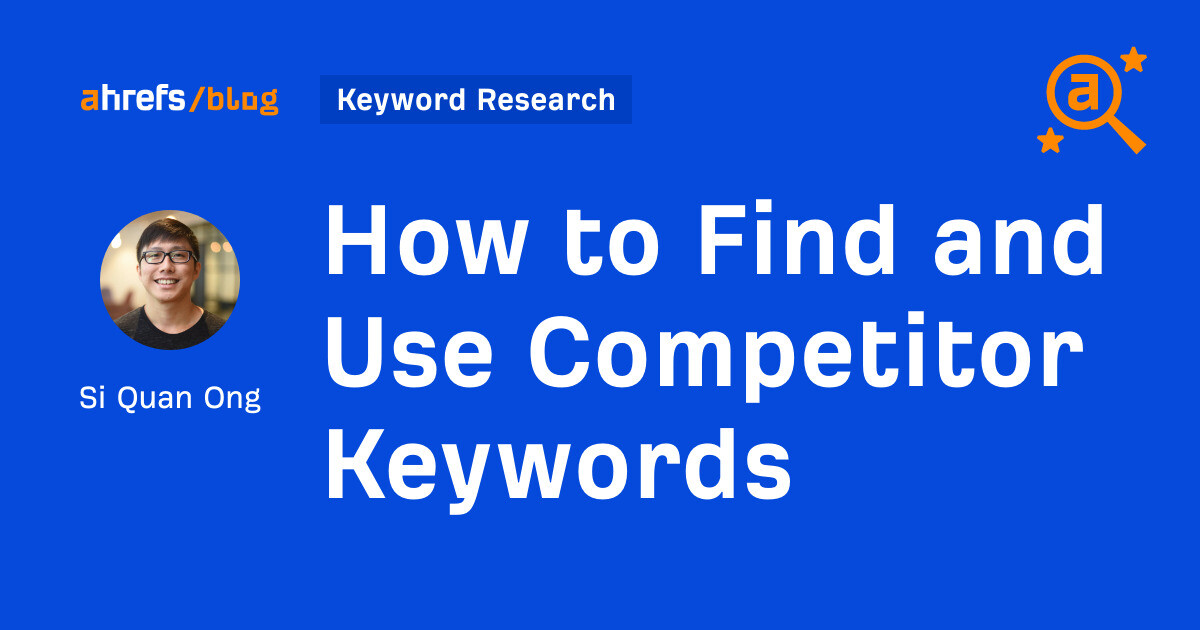
Competitor keywords are the keywords your rivals rank for in Google’s search results. They may rank organically or pay for Google Ads to rank in the paid results.
Knowing your competitors’ keywords is the easiest form of keyword research. If your competitors rank for or target particular keywords, it might be worth it for you to target them, too.
There is no way to see your competitors’ keywords without a tool like Ahrefs, which has a database of keywords and the sites that rank for them. As far as we know, Ahrefs has the biggest database of these keywords.
How to find all the keywords your competitor ranks for
- Go to Ahrefs’ Site Explorer
- Enter your competitor’s domain
- Go to the Organic keywords report
The report is sorted by traffic to show you the keywords sending your competitor the most visits. For example, Mailchimp gets most of its organic traffic from the keyword “mailchimp.”


Since you’re unlikely to rank for your competitor’s brand, you might want to exclude branded keywords from the report. You can do this by adding a Keyword > Doesn’t contain filter. In this example, we’ll filter out keywords containing “mailchimp” or any potential misspellings:
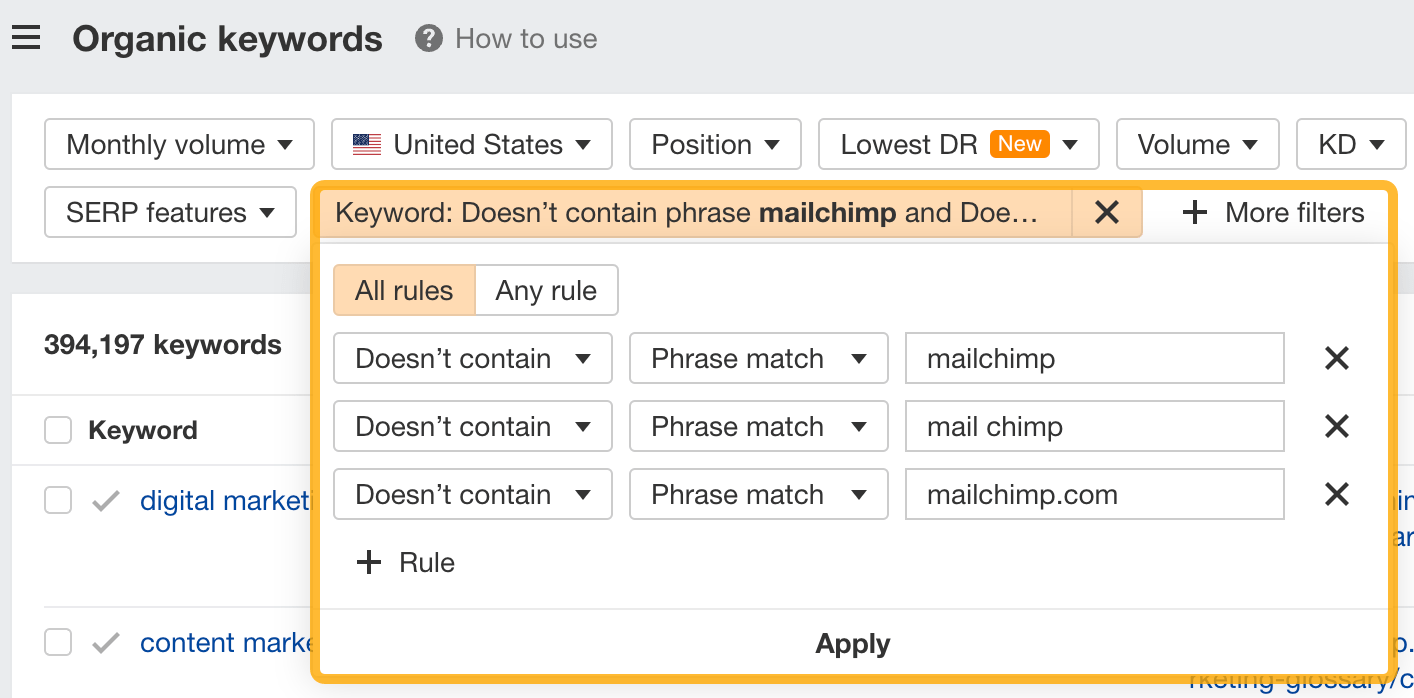

If you’re a new brand competing with one that’s established, you might also want to look for popular low-difficulty keywords. You can do this by setting the Volume filter to a minimum of 500 and the KD filter to a maximum of 10.
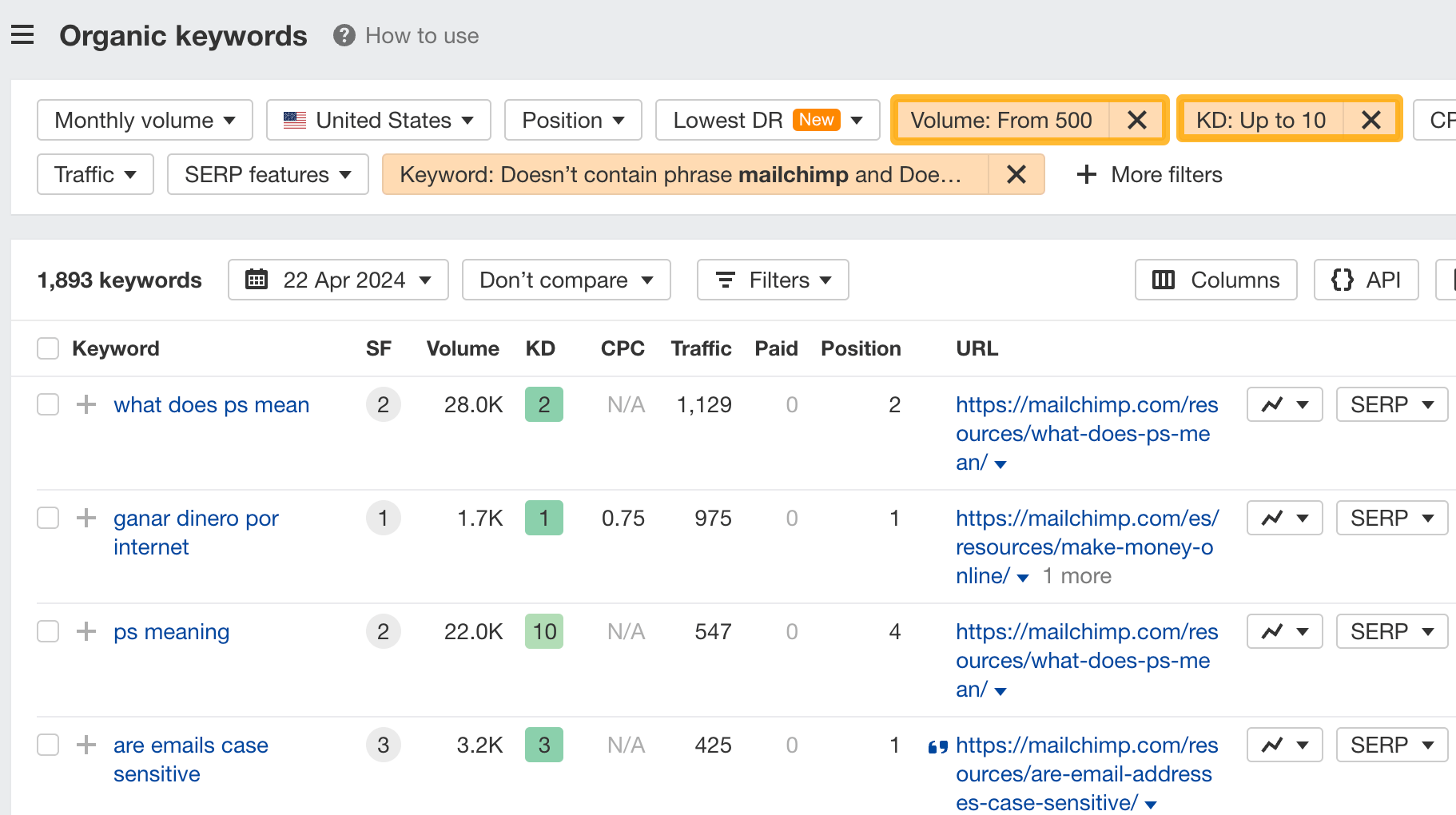

How to find keywords your competitor ranks for, but you don’t
- Go to Competitive Analysis
- Enter your domain in the This target doesn’t rank for section
- Enter your competitor’s domain in the But these competitors do section
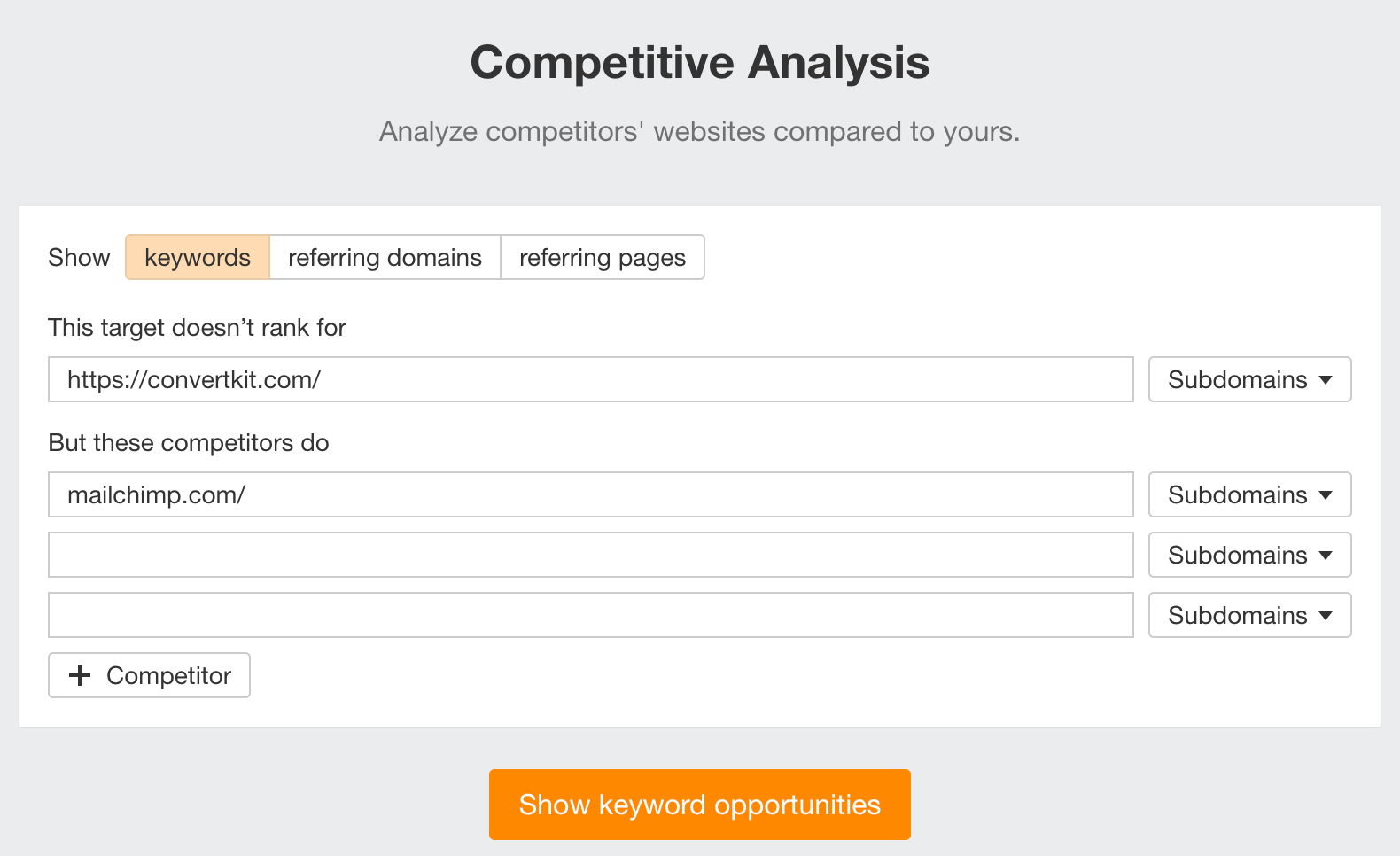

Hit “Show keyword opportunities,” and you’ll see all the keywords your competitor ranks for, but you don’t.
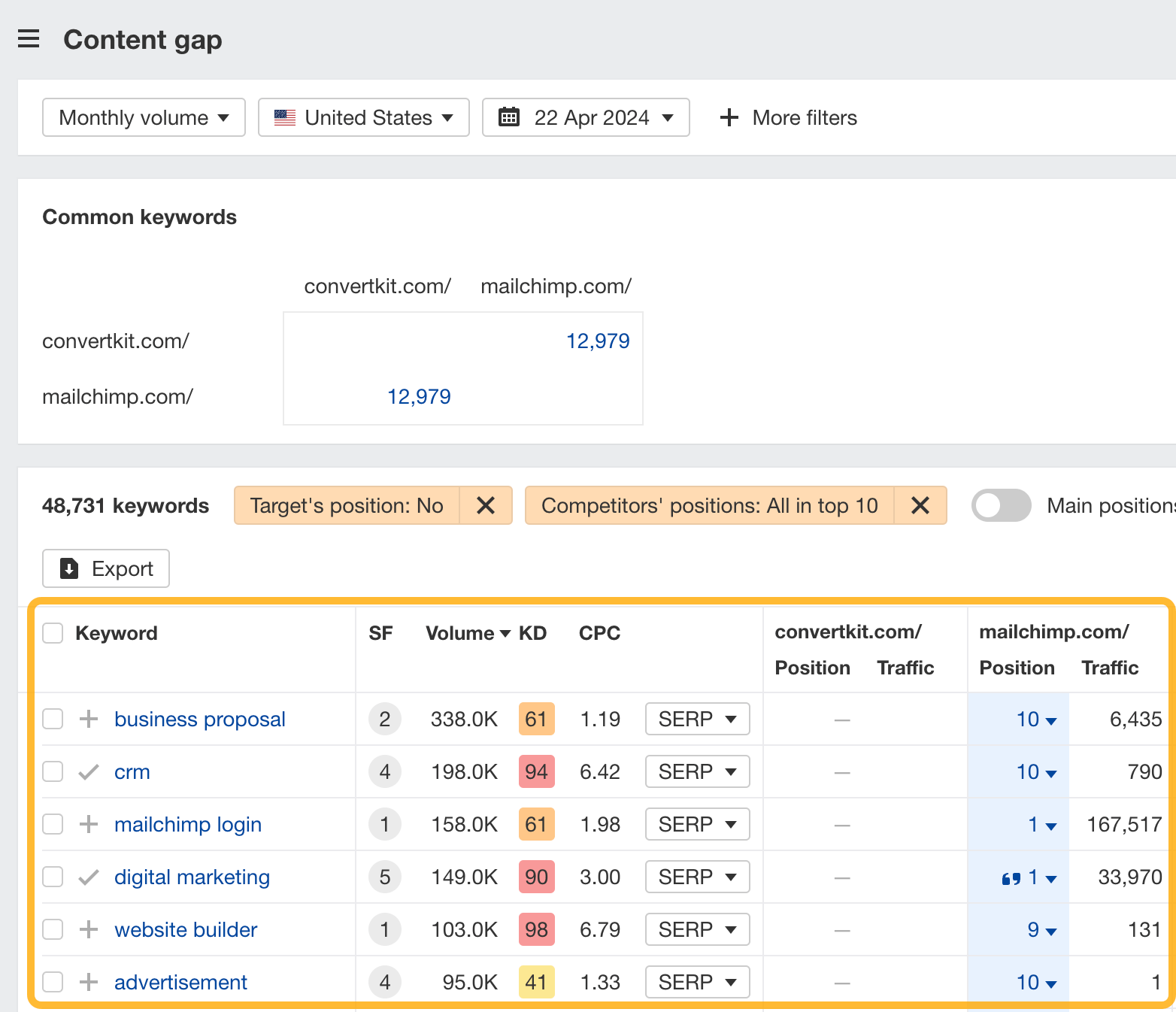

You can also add a Volume and KD filter to find popular, low-difficulty keywords in this report.
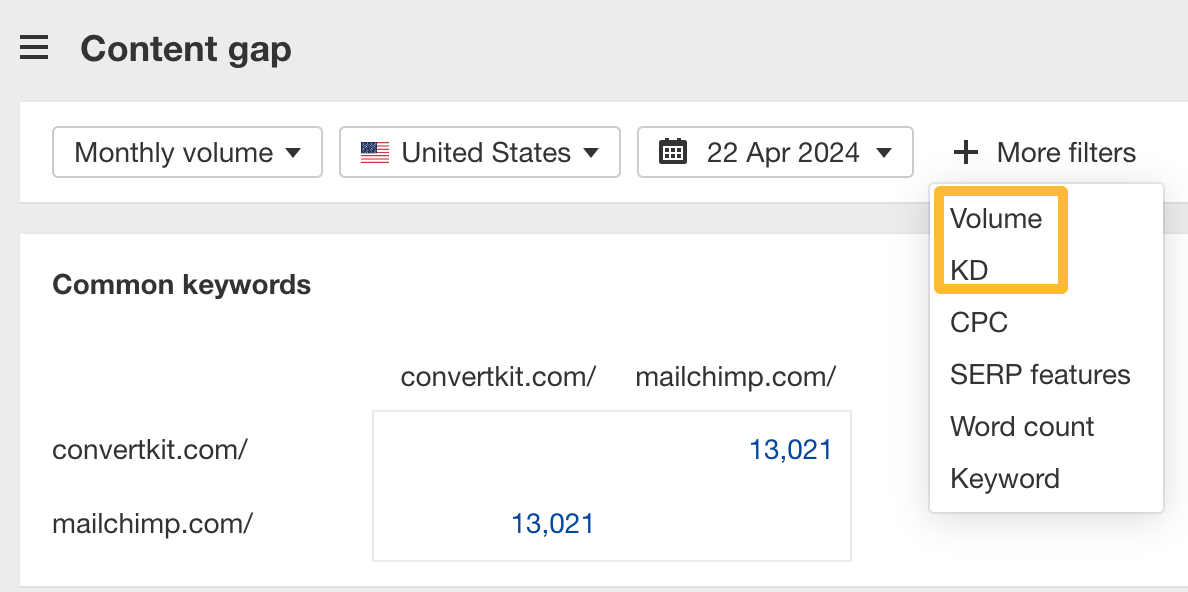

How to find keywords multiple competitors rank for, but you don’t
- Go to Competitive Analysis
- Enter your domain in the This target doesn’t rank for section
- Enter the domains of multiple competitors in the But these competitors do section
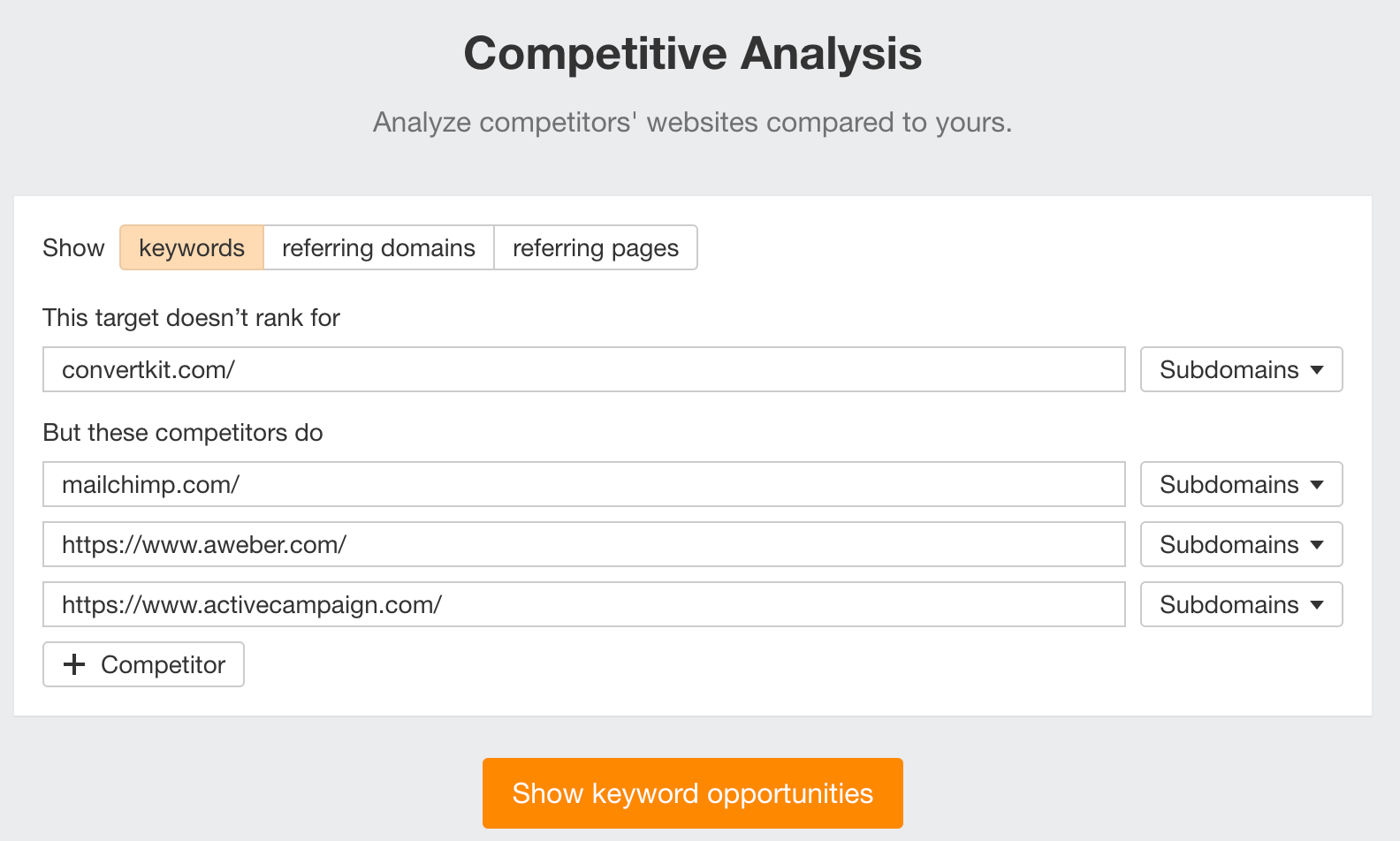

You’ll see all the keywords that at least one of these competitors ranks for, but you don’t.
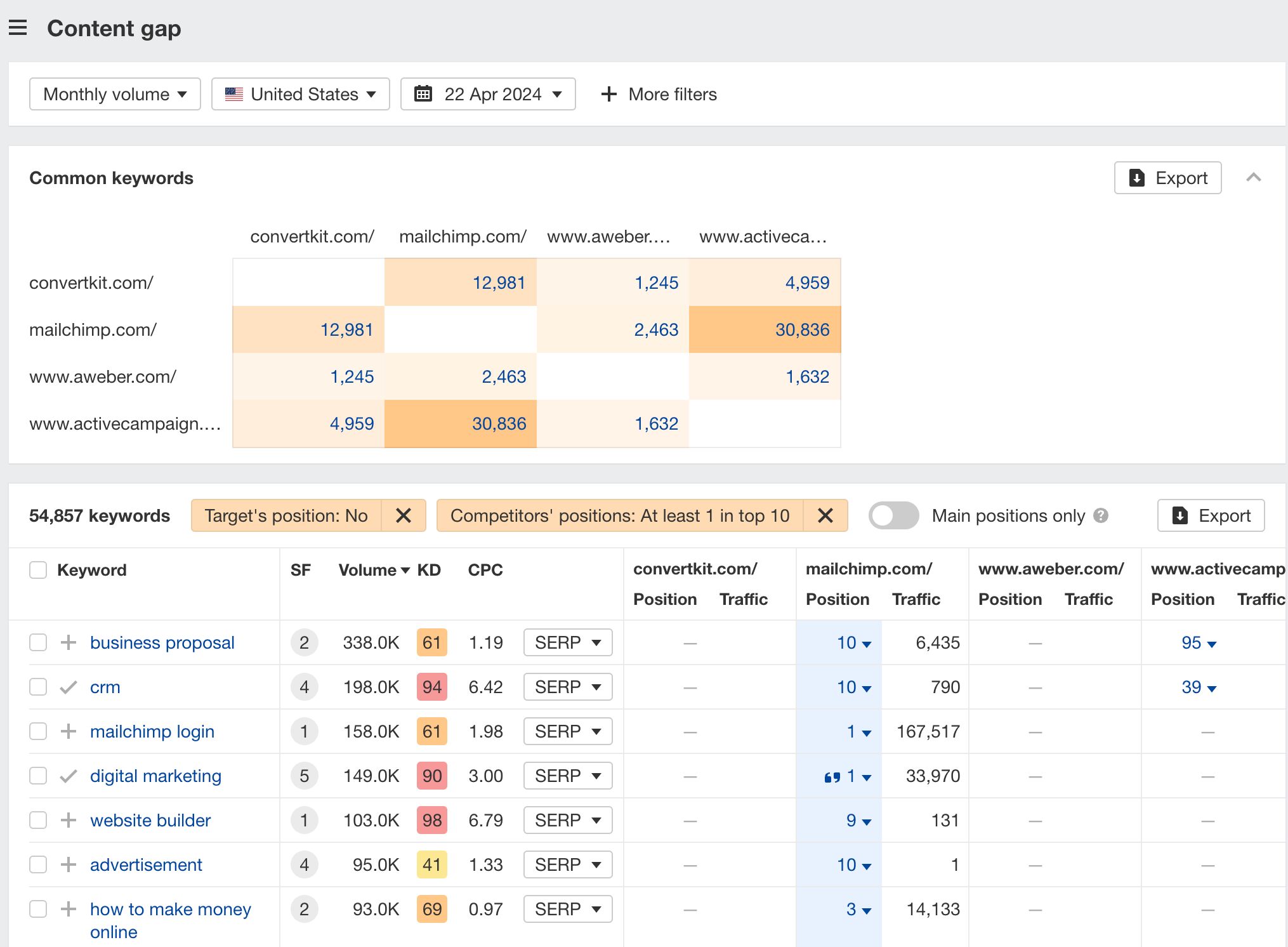

You can also narrow the list down to keywords that all competitors rank for. Click on the Competitors’ positions filter and choose All 3 competitors:
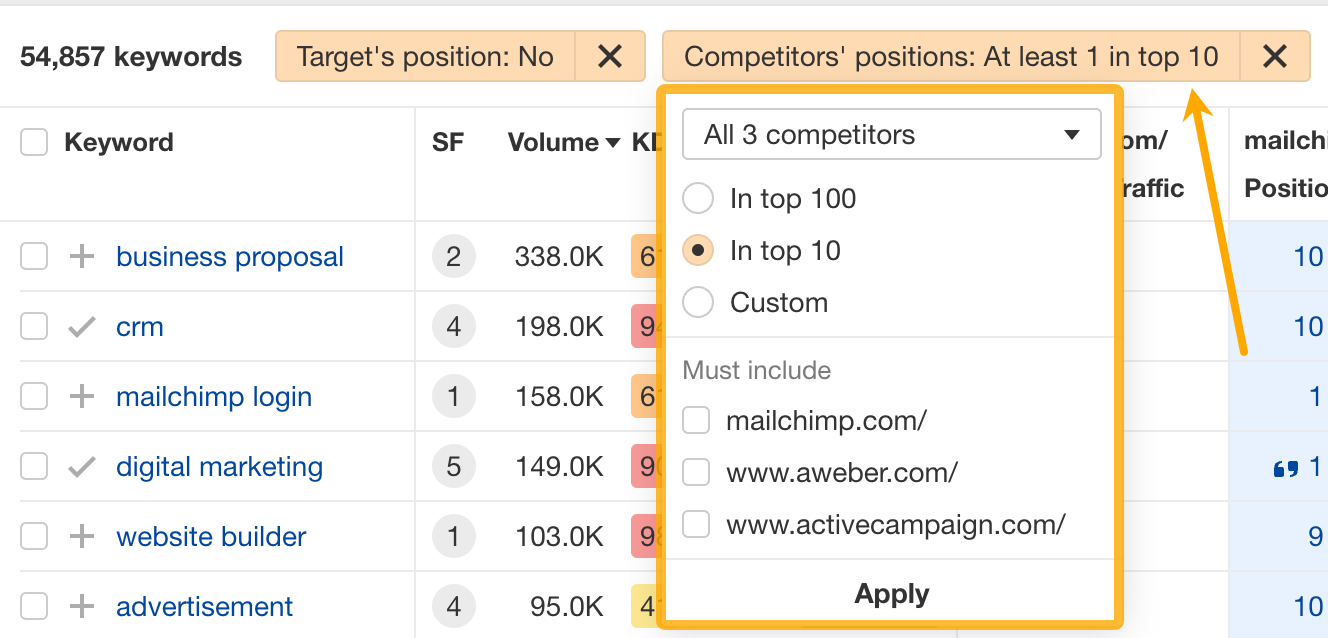

- Go to Ahrefs’ Site Explorer
- Enter your competitor’s domain
- Go to the Paid keywords report
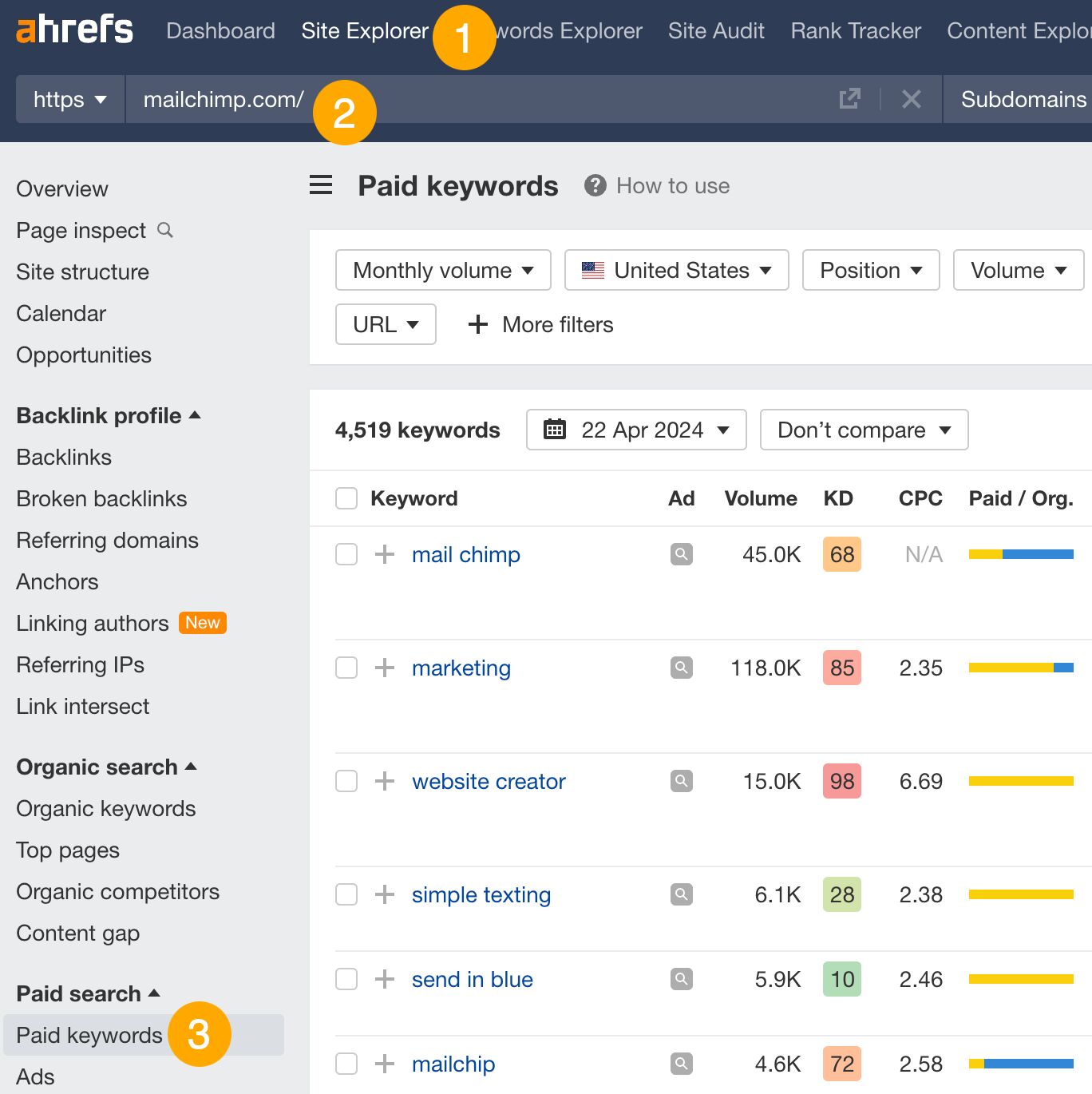

This report shows you the keywords your competitors are targeting via Google Ads.
Since your competitor is paying for traffic from these keywords, it may indicate that they’re profitable for them—and could be for you, too.
You know what keywords your competitors are ranking for or bidding on. But what do you do with them? There are basically three options.
1. Create pages to target these keywords
You can only rank for keywords if you have content about them. So, the most straightforward thing you can do for competitors’ keywords you want to rank for is to create pages to target them.
However, before you do this, it’s worth clustering your competitor’s keywords by Parent Topic. This will group keywords that mean the same or similar things so you can target them all with one page.
Here’s how to do that:
- Export your competitor’s keywords, either from the Organic Keywords or Content Gap report
- Paste them into Keywords Explorer
- Click the “Clusters by Parent Topic” tab
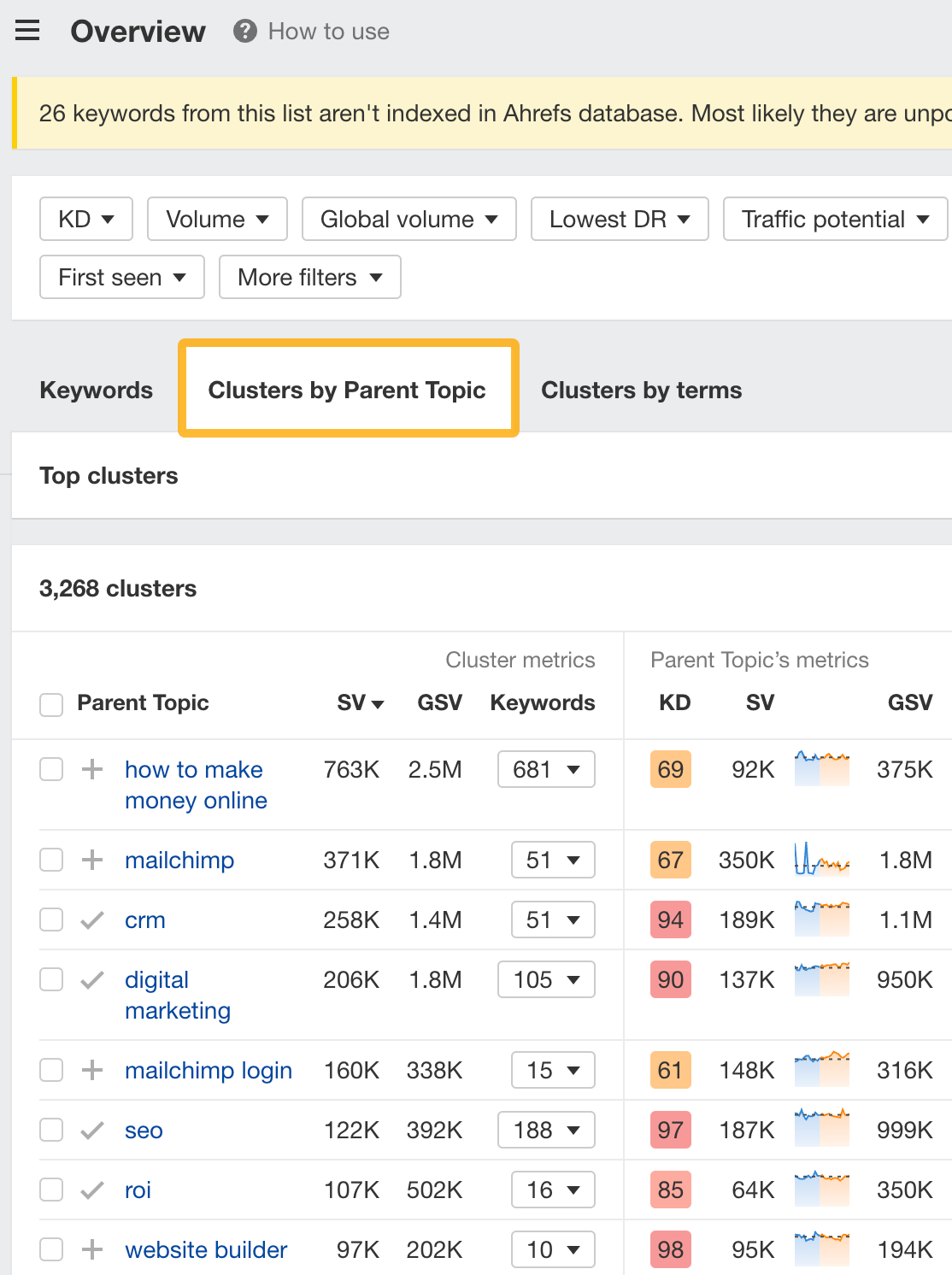

For example, MailChimp ranks for keywords like “what is digital marketing” and “digital marketing definition.” These and many others get clustered under the Parent Topic of “digital marketing” because people searching for them are all looking for the same thing: a definition of digital marketing. You only need to create one page to potentially rank for all these keywords.
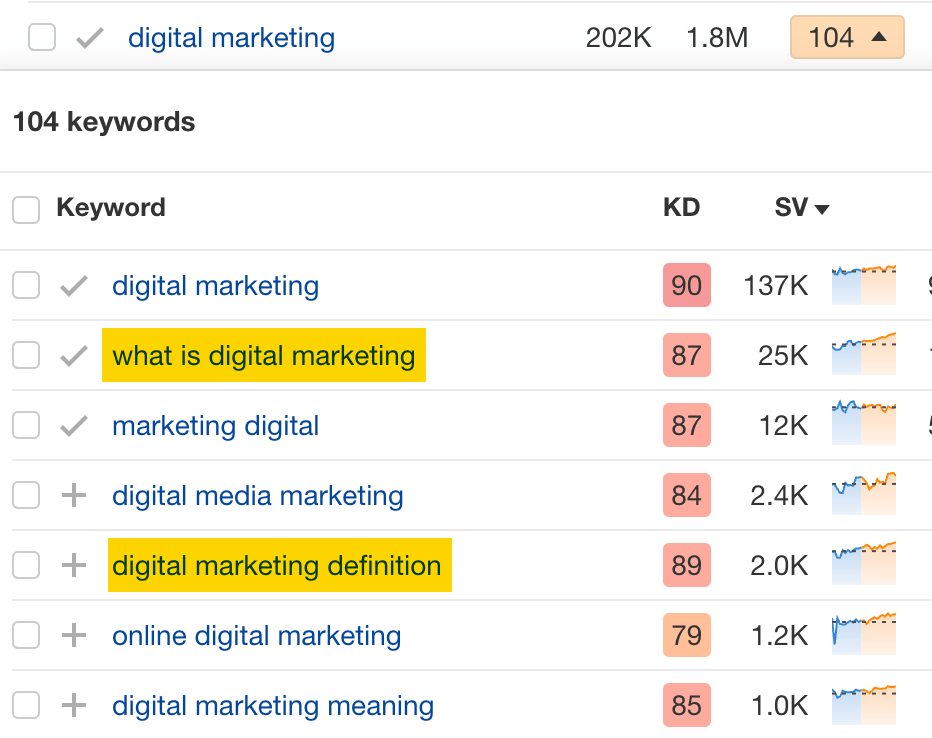

2. Optimize existing content by filling subtopics
You don’t always need to create new content to rank for competitors’ keywords. Sometimes, you can optimize the content you already have to rank for them.
How do you know which keywords you can do this for? Try this:
- Export your competitor’s keywords
- Paste them into Keywords Explorer
- Click the “Clusters by Parent Topic” tab
- Look for Parent Topics you already have content about
For example, if we analyze our competitor, we can see that seven keywords they rank for fall under the Parent Topic of “press release template.”


If we search our site, we see that we already have a page about this topic.


If we click the caret and check the keywords in the cluster, we see keywords like “press release example” and “press release format.”
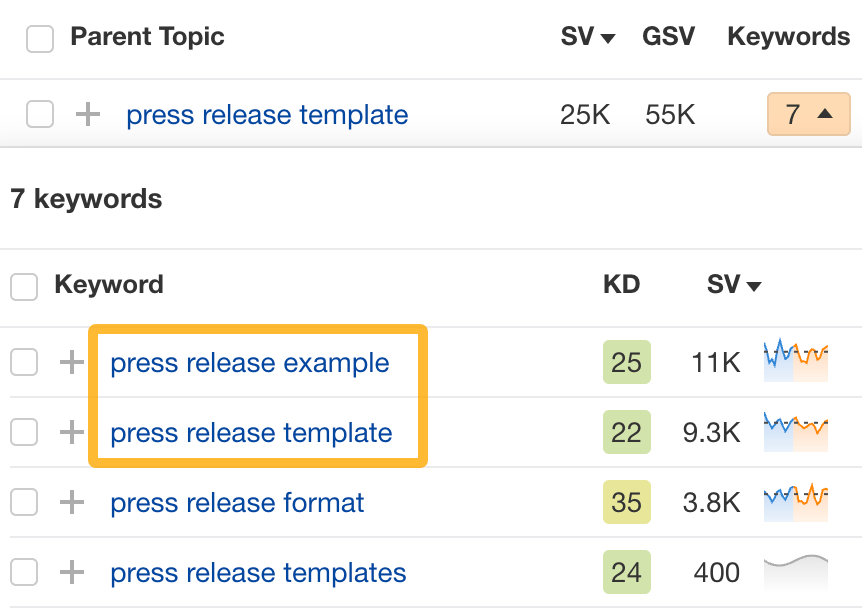

To rank for the keywords in the cluster, we can probably optimize the page we already have by adding sections about the subtopics of “press release examples” and “press release format.”
3. Target these keywords with Google Ads
Paid keywords are the simplest—look through the report and see if there are any relevant keywords you might want to target, too.
For example, Mailchimp is bidding for the keyword “how to create a newsletter.”


If you’re ConvertKit, you may also want to target this keyword since it’s relevant.
If you decide to target the same keyword via Google Ads, you can hover over the magnifying glass to see the ads your competitor is using.
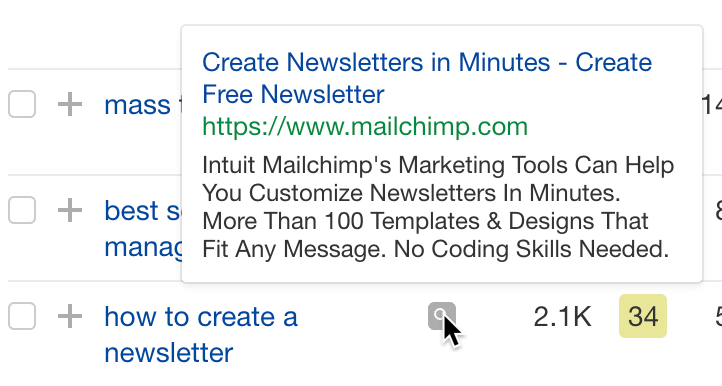

You can also see the landing page your competitor directs ad traffic to under the URL column.


Learn more
Check out more tutorials on how to do competitor keyword analysis:
SEO
Google Confirms Links Are Not That Important

Google’s Gary Illyes confirmed at a recent search marketing conference that Google needs very few links, adding to the growing body of evidence that publishers need to focus on other factors. Gary tweeted confirmation that he indeed say those words.
Background Of Links For Ranking
Links were discovered in the late 1990’s to be a good signal for search engines to use for validating how authoritative a website is and then Google discovered soon after that anchor text could be used to provide semantic signals about what a webpage was about.
One of the most important research papers was Authoritative Sources in a Hyperlinked Environment by Jon M. Kleinberg, published around 1998 (link to research paper at the end of the article). The main discovery of this research paper is that there is too many web pages and there was no objective way to filter search results for quality in order to rank web pages for a subjective idea of relevance.
The author of the research paper discovered that links could be used as an objective filter for authoritativeness.
Kleinberg wrote:
“To provide effective search methods under these conditions, one needs a way to filter, from among a huge collection of relevant pages, a small set of the most “authoritative” or ‘definitive’ ones.”
This is the most influential research paper on links because it kick-started more research on ways to use links beyond as an authority metric but as a subjective metric for relevance.
Objective is something factual. Subjective is something that’s closer to an opinion. The founders of Google discovered how to use the subjective opinions of the Internet as a relevance metric for what to rank in the search results.
What Larry Page and Sergey Brin discovered and shared in their research paper (The Anatomy of a Large-Scale Hypertextual Web Search Engine – link at end of this article) was that it was possible to harness the power of anchor text to determine the subjective opinion of relevance from actual humans. It was essentially crowdsourcing the opinions of millions of website expressed through the link structure between each webpage.
What Did Gary Illyes Say About Links In 2024?
At a recent search conference in Bulgaria, Google’s Gary Illyes made a comment about how Google doesn’t really need that many links and how Google has made links less important.
Patrick Stox tweeted about what he heard at the search conference:
” ‘We need very few links to rank pages… Over the years we’ve made links less important.’ @methode #serpconf2024″
Google’s Gary Illyes tweeted a confirmation of that statement:
“I shouldn’t have said that… I definitely shouldn’t have said that”
Why Links Matter Less
The initial state of anchor text when Google first used links for ranking purposes was absolutely non-spammy, which is why it was so useful. Hyperlinks were primarily used as a way to send traffic from one website to another website.
But by 2004 or 2005 Google was using statistical analysis to detect manipulated links, then around 2004 “powered-by” links in website footers stopped passing anchor text value, and by 2006 links close to the words “advertising” stopped passing link value, links from directories stopped passing ranking value and by 2012 Google deployed a massive link algorithm called Penguin that destroyed the rankings of likely millions of websites, many of which were using guest posting.
The link signal eventually became so bad that Google decided in 2019 to selectively use nofollow links for ranking purposes. Google’s Gary Illyes confirmed that the change to nofollow was made because of the link signal.
Google Explicitly Confirms That Links Matter Less
In 2023 Google’s Gary Illyes shared at a PubCon Austin that links were not even in the top 3 of ranking factors. Then in March 2024, coinciding with the March 2024 Core Algorithm Update, Google updated their spam policies documentation to downplay the importance of links for ranking purposes.
The documentation previously said:
“Google uses links as an important factor in determining the relevancy of web pages.”
The update to the documentation that mentioned links was updated to remove the word important.
Links are not just listed as just another factor:
“Google uses links as a factor in determining the relevancy of web pages.”
At the beginning of April Google’s John Mueller advised that there are more useful SEO activities to engage on than links.
Mueller explained:
“There are more important things for websites nowadays, and over-focusing on links will often result in you wasting your time doing things that don’t make your website better overall”
Finally, Gary Illyes explicitly said that Google needs very few links to rank webpages and confirmed it.
I shouldn’t have said that… I definitely shouldn’t have said that
— Gary 鯨理/경리 Illyes (so official, trust me) (@methode) April 19, 2024
Why Google Doesn’t Need Links
The reason why Google doesn’t need many links is likely because of the extent of AI and natural language undertanding that Google uses in their algorithms. Google must be highly confident in its algorithm to be able to explicitly say that they don’t need it.
Way back when Google implemented the nofollow into the algorithm there were many link builders who sold comment spam links who continued to lie that comment spam still worked. As someone who started link building at the very beginning of modern SEO (I was the moderator of the link building forum at the #1 SEO forum of that time), I can say with confidence that links have stopped playing much of a role in rankings beginning several years ago, which is why I stopped about five or six years ago.
Read the research papers
Authoritative Sources in a Hyperlinked Environment – Jon M. Kleinberg (PDF)
The Anatomy of a Large-Scale Hypertextual Web Search Engine
Featured Image by Shutterstock/RYO Alexandre
-

 PPC5 days ago
PPC5 days ago19 Best SEO Tools in 2024 (For Every Use Case)
-
SEARCHENGINES7 days ago
Daily Search Forum Recap: April 16, 2024
-

 SEO7 days ago
SEO7 days agoGoogle Clarifies Vacation Rental Structured Data
-

 MARKETING6 days ago
MARKETING6 days agoStreamlining Processes for Increased Efficiency and Results
-
SEARCHENGINES6 days ago
Daily Search Forum Recap: April 17, 2024
-
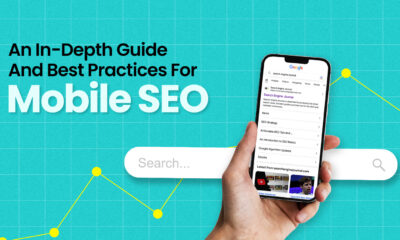
 SEO6 days ago
SEO6 days agoAn In-Depth Guide And Best Practices For Mobile SEO
-

 PPC6 days ago
PPC6 days ago97 Marvelous May Content Ideas for Blog Posts, Videos, & More
-

 MARKETING5 days ago
MARKETING5 days agoEcommerce evolution: Blurring the lines between B2B and B2C






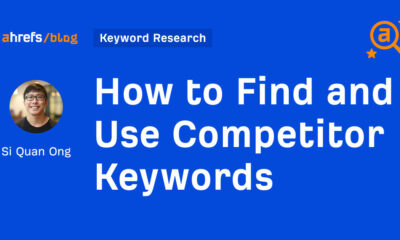







You must be logged in to post a comment Login